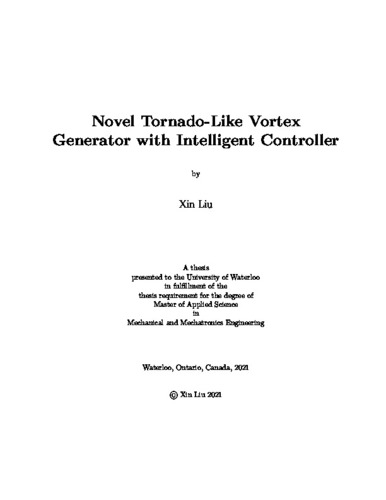UWSpace will be migrating to a new version of its software from July 29th to August 1st. UWSpace will be offline for all UW community members during this time.
Novel Tornado-Like Vortex Generator with Intelligent Controller
| dc.contributor.author | LIU, XIN | |
| dc.date.accessioned | 2021-01-29 18:52:28 (GMT) | |
| dc.date.available | 2021-01-29 18:52:28 (GMT) | |
| dc.date.issued | 2021-01-29 | |
| dc.date.submitted | 2021-01-25 | |
| dc.identifier.uri | http://hdl.handle.net/10012/16765 | |
| dc.description.abstract | Cooking fumes may cause multiple adverse health effects, and range hoods play central roles in controlling indoor air pollution caused by cooking fumes. However, the traditional design of the range hoods has a low efficiency due to its working principle, and the efficiency decreases rapidly as the mounting height of the exhaust hood increases. This thesis is aimed at design and building a novel tornado-like vortex generator (TLVG) with an intelligent controller to enhance the efficiency of traditional range hood. Both experimental results and numerical simulation indicate that most of the cooking fumes are spreading to surrounding areas when the traditional range hood is working alone, while the cooking fumes are drawn into the tornado-like vortex and exhausted through the range hood when the novel TLVG is on. The effects of various factors on the efficiency of sucking cooking fumes are analyzed by orthogonal experiment design. The results show that the key factor affecting the performance of the TLVG is the horizontal jet angle. A higher jet velocity results in a lower negative pressure, which helps concentrate and exhaust the fume. The results also reveal that the exhaust flow velocity marginally affects the pressure around the source of cooking fumes, but the tornado-like vortex cannot be produced when the value of the exhaust flow velocity is too high. In addition, the figures of the velocity field, pressure field, and tracking particle field are plotted and analyzed. In this thesis, an intelligent controller of TLVG is designed and simulated to adapt to various types of range hoods. Adaptive-Network-based Fuzzy Inference System (ANFIS) is used in this intelligent controller, which combines the merits of both Fuzzy Inference Systems and Neural Networks. The results from the numerical simulation of the TLVG can be used to train and test the neural fuzzy system. Besides, Particle Swarm Optimization (PSO) is used for effective training in ANFIS networks. Digital simulation results demonstrate that the designed ANFIS-Swarm controller realizes a better prediction of the checking data than that from a basic ANFIS controller. This study provides information for improving the kitchen environment, and it can also be applied to different types of range hood, exhaust ventilation system, and air pollution control. | en |
| dc.language.iso | en | en |
| dc.publisher | University of Waterloo | en |
| dc.subject | tornado-like vortex generator | en |
| dc.subject | range hood | en |
| dc.subject | parametric study | en |
| dc.subject | intelligent controller | en |
| dc.title | Novel Tornado-Like Vortex Generator with Intelligent Controller | en |
| dc.type | Master Thesis | en |
| dc.pending | false | |
| uws-etd.degree.department | Mechanical and Mechatronics Engineering | en |
| uws-etd.degree.discipline | Mechanical Engineering | en |
| uws-etd.degree.grantor | University of Waterloo | en |
| uws-etd.degree | Master of Applied Science | en |
| uws-etd.embargo.terms | 0 | en |
| uws.contributor.advisor | Lien, Fue-Sang | |
| uws.contributor.advisor | Melek, William | |
| uws.contributor.affiliation1 | Faculty of Engineering | en |
| uws.published.city | Waterloo | en |
| uws.published.country | Canada | en |
| uws.published.province | Ontario | en |
| uws.typeOfResource | Text | en |
| uws.peerReviewStatus | Unreviewed | en |
| uws.scholarLevel | Graduate | en |

